Cart abandonment is one of the most significant issues any eCommerce store can face. It’s equally unpleasant as it is unavoidable.
The shopping cart abandonment rate stood at 79.53% in 2023, according to SalesCycle data reported by Baymard Institute. That’s almost 8 out of 10 website visitors adding items to a cart on an ecommerce store just like yours and then failing to complete their online purchase.
It leaves us, marketers, puzzled: what can we do to encourage buyers to complete the checkout process?
But before we can answer that question, we need to ask ourselves why customers decided to leave in the first place.
Why customers abandon their carts
Anything could’ve happened to make a potential customer abandon their cart. An unexpected phone call, milk boiling out of the pot, or a timely notification could’ve simply distracted the person.
In such scenarios, a simple “Don’t leave your cart hanging” message can be enough to get the customers to complete their orders.
But then we also have other, more complex issues that push prospective customers into abandoning their carts. These include
- Unexpected shipping rates
- Hidden taxes
- A better price match
- Payment security concerns
- Limited payment options
Here are the top reasons why online shoppers abandon carts in 2025, according to Statista.

Understanding the reasons behind cart abandonment in your own store is the first step toward resolving the issue. Do you need to include more payment options? Should you disclose all costs and fees in advance? Or perhaps you need to clarify your shipping and return policies?
That said, setting up an abandoned cart email sequence is one way to recover these lost sales.
Research shows that abandoned cart emails get an open rate of 41.18% and click-through rate of 9.50%. Revenue per recipient of these emails is $5.81!
That’s why we’ve prepared 15 real-life effective abandoned cart email examples that will help you recover lost sales and gain the most benefits from your next remarketing campaign.
Did you know? Saving abandoned carts is easy with GetResponse. Try it for free and start capturing lost sales in moments, using stunning prebuilt abandoned cart email templates. Want to see it in action first? Then scroll down and check out our video walkthrough.
Turn Cart Abandoners Into Customers GetResponse
Don’t let 79% of your potential sales slip away. Recover abandoned carts automatically with proven email templates and smart automation workflows that convert browsers into buyers.
Best abandoned cart email examples
Now, for the best part: here are the top abandoned cart recovery emails we’ve seen online.
1. Send a helpful reminder
This type of abandonment cart email is most effective for customers who have simply forgotten to complete their purchase after getting distracted by something else.

When done right, this kind of email is perceived as genuinely helpful and non-intrusive.
It says, “We know how valuable your time is and don’t want to waste it. We’ve saved this for you in case you forgot about it. Let us know if you still want it.” It gives the client a little nudge to finish what they started whenever they get a free moment to do so.
2. Offer options
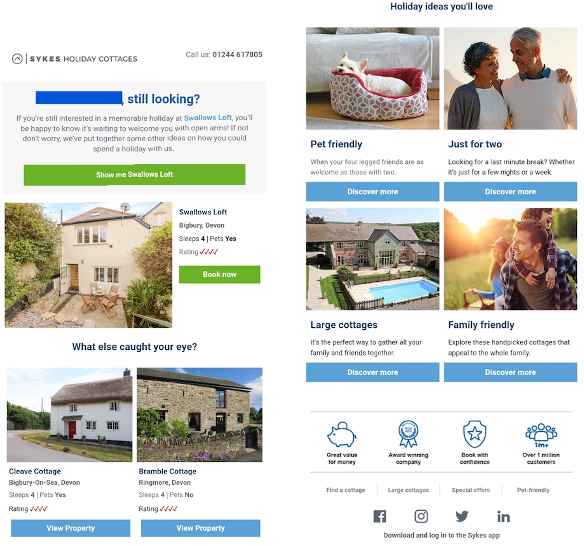
Sometimes, your visitors may not be able to find exactly what they are looking for. They abandon their carts at the checkout page because the options they found don’t quite meet their needs. For such cases, using a follow-up email that offers alternative options the customer might have missed is a great approach.
Predicting what a customer might like may sound complex, so that’s where marketing automation comes in. Whether you heavily rely on cookies or use a trustworthy marketing automation software like GetResponse, data collection becomes almost effortless!
The GetResponse marketing automation software tracks customer behavior on your site. It sees what product pages they visit. The platform also tracks user behavior on email, like the links they click. This data makes it possible for our solution to send automated emails with personalized product recommendations. The result is higher engagement rates and conversions.
Learn more about how GeResponse marketing automation works here.
3. Personalize the message
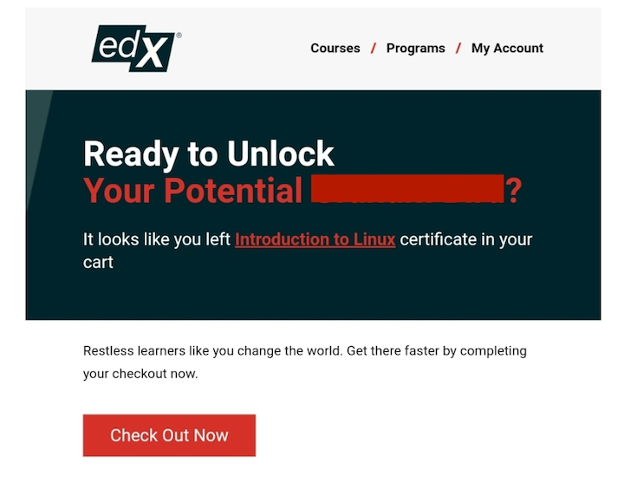
You can no longer surprise your customers or email subscribers with personalization. That’s because personalization has become an integral part of successful brand communications. So we can’t stress enough the importance of personalizing each of your messages.
Today, personalization goes beyond using a person’s first name in the subject line — no one will be swooped off their feet by this simple online courtesy (although 94% of professionals and customers agree that personalization is crucial for a successful email marketing strategy).
Instead, you need to keep an eye on more intricate details, such as their browsing history on your website and the category of products they seem to be most interested in, among other things.
Pro tip: When it comes to personalization, it is crucial to pay extra attention to your contact list. You don’t want the email marketing software to insert your client’s IP address instead of their first name, or suggest they buy some “John” instead of the target product category. Thanks to regular list hygiene, you can ensure that all your contacts are up-to-date, non-duplicated, and well-segmented for a specific product offer you’ve prepared.
4. Keep an eye for user-friendly design

The visual appearance of your email is very important. It takes humans just over 1/100th of a second to process an image. In contrast, it takes us 0.8-1.6 seconds to understand an 8-word sentence. If reading your emails feels like a chore, you may not even get past the subject line.
Similarly, including color in your emails can help grab and keep your readers’ attention by making the most important part of your email stand out. The use of color improved a person’s willingness to read by 80% and attention span by 82%.
Composing your email with these two statistics in mind can help you minimize the damage caused by cart abandonment simply by appealing to people’s visual perception.
Choose on-brand color combinations that catch the eye, and use graphics and photographs to let your products speak for themselves.
Show, don’t tell.
Read more: Guide to email design
5. Leverage FOMO

The fear of missing out is a powerful tool marketers often use as a crucial component of their abandoned cart emails. Fomo creates urgency and the illusion of scarcity.
The example above is one of the abandoned cart email templates from Brand Alley, which informs the recipient that their items are still saved but not on hold — meaning someone else might purchase them if they don’t go back and complete their order right away.
Creating urgency is a good technique to use if the customer’s only hesitancy is uncertainty over the specific product. By emphasizing that a particular product your client is interested in is in high demand, you can trigger that person to want the item more, thus speeding up their conversion time.
Other great examples of FOMO emails feature a countdown. This timer shows the customer that they have a limited time to take advantage of a perk like a coupon, discount code, or free shipping. You can even show how many units of the abandoned items are left in stock.
6. Offer a killer discount
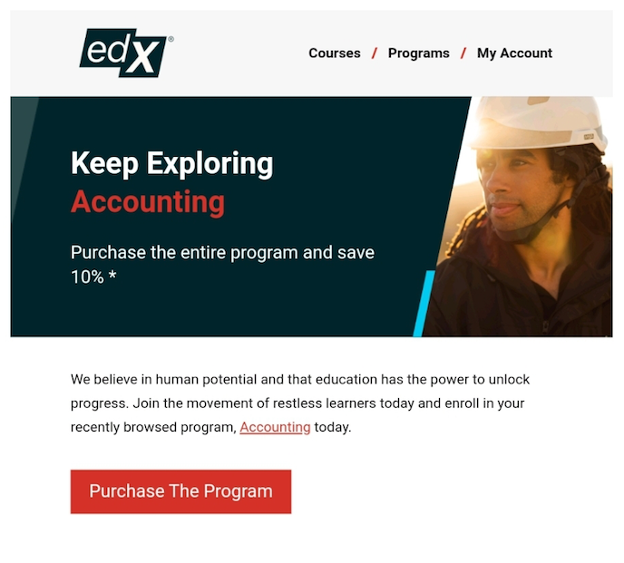
Offering a discount code, as shown in the example above by edX, could tip the balance for shoppers who abandoned their items because of pricing-related concerns. This approach works best if you have a high-profit margin or if the items are already on sale and you want to clear the end-of-line stock.
Click here to learn more about discount strategies for your shop!
Oftentimes, wasting the warehouse space on a few slow-moving items is more costly than selling the product at a cheaper rate. In such scenarios, it makes perfect sense to discount those products whenever they’re added to carts.
Related: How to use email promo codes in GetResponse
Smart discount strategies can recover up to 10.7% of abandoned carts. The key is timing your offers right and using automation to deliver them at the perfect moment when customers are most likely to convert.
7. Provide an extra incentive
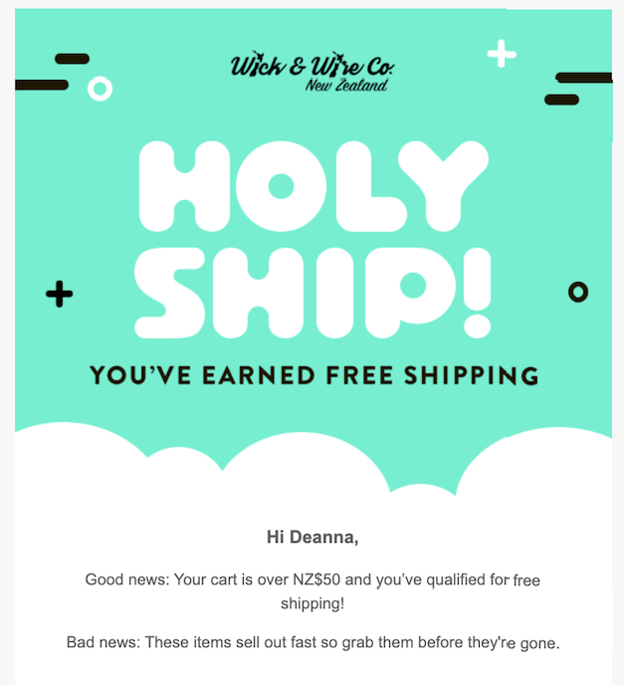
Image source: Pinterest
You don’t have to give out discount codes to encourage customers to complete their purchases. You can provide other kinds of incentives that help your lost customers commit to your product and recover abandoned carts. For example, you could offer free shipping or a small gift as an incentive.
In fact, unexpected shipping costs are among the top reasons for cart abandonment. That’s why something as simple as free shipping can significantly increase your conversion rates.
At the same time, you don’t even have to lose money on the logistics — the final price of the product can include most of the delivery and shipment costs for the merchant.
8. Include a clever subject line

There is a lot of debate over what makes a good subject line. Many copywriters think short, snappy subject lines work best, but our own research and statistical data analysis from thousands of emails sent through our services show that longer subject lines actually get more opens than shorter ones.
In fact, length is just a small part of the bigger picture. What really separates a good subject line from an outstanding one is clarity: your end goal should always be to ensure that your subject reveals just enough detail of what the message is all about — not too much, not too little.
What we do suggest is that the subject line makes it clear what your email is about. If you have done your market research right and understand your audience, you will be sending only relevant emails to a quality list of subscribers.
Pro tip: Choose a subject line that aligns with the tone and angle of your abandonment email. Your customers only have a limited amount of time every day to spend scrolling and reading emails, so they will be picky. The secret to a successful email marketing campaign is delivering content your target wants to read.
9. Don’t underestimate preview texts
If a subject line tells a reader what to expect, a preview is like a tasting note for your email. It’s a space where you can tell the reader exactly what they’ll find if they open your communication.
On mobile devices, it comes underneath the subject line, but on desktops, it often appears right after the subject line.
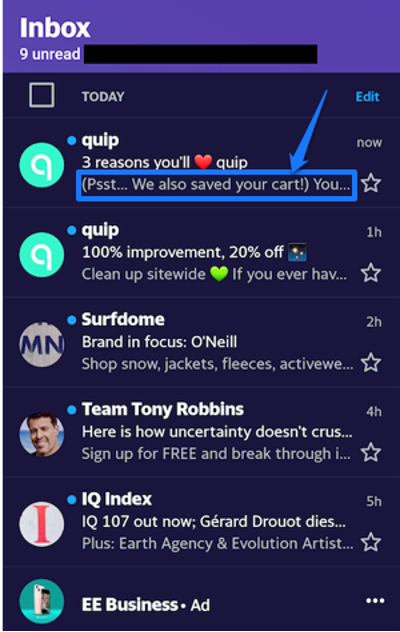
When composing an ideal abandoned cart email copy, we often get distracted with courtesy texts, such as welcome introductions or small talk. There’s nothing wrong with wanting our message to sound conversational and friendly, and often it pays off.
However, seeing yet another “Hi, Jackie” will hardly get someone to click. And that’s exactly why many email marketing platforms allow you to craft a dedicated preview text.
Subject lines are genius in their brevity. As a rule, you have around 60 characters to intrigue your reader. Preview, in turn, grants you another portion of symbols to fill with useful information. The example above perfectly demonstrates a smart use of preview texts.
10. Keep it simple

If you think your customers are predominantly busy people and you fear that overwhelming them with an abandoned cart email that is “too salesy” might drive them away, rely on a simple approach instead and watch your cart abandonment rate drop.
Not all businesses can build a personal relationship with each customer. If you find yourself in this situation, the best way to communicate with your prospects is one that maintains trust. If they are busy, accept that you’re not the top priority in their life.
You love your products, you know they’re the best of the kind, but not every one of your lost customers or subscribers is going to be a raving fan. That’s okay. You can still convert them with simple reminders.
In this example from the online store Go Outdoors, they’ve kept it simple, professional, visual, and clear. They thank the visitor for browsing their site before commenting on the basket of unbought goods.
The call-to-action is large and clear. If the reader wants to check their basket, it’s a quick and easy click that separates cart abandonment from a successful conversion.
11. Encourage customers to get in touch
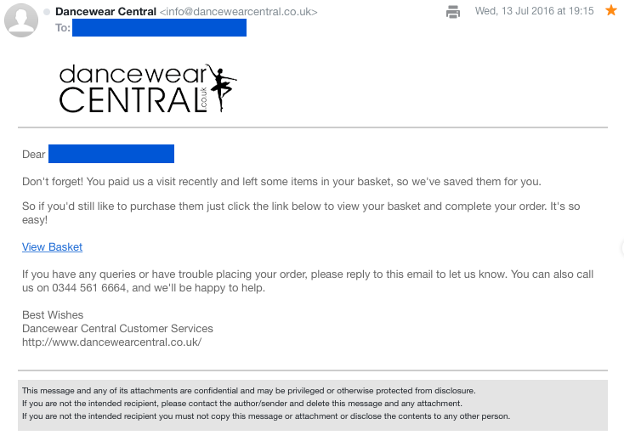
Sometimes, it’s better to just ask the customer why they didn’t complete their order rather than make assumptions.
As we’ve mentioned at the beginning of this post, it’s possible that life just happens, and you are unable to complete your order because the pasta is boiling out. No marketer, regardless of the quality of their tracking software, would ever be able to guess the real reason behind the abandoned cart.
That’s why, if your goal is to actually improve your site’s performance and minimize bounces, the best strategy is to simply ask what happened. Maybe it was the shipping costs, maybe their kid just came home from school, or maybe your UX lacks the “continue to checkout” button. Just ask!
12. Incorporate social proof
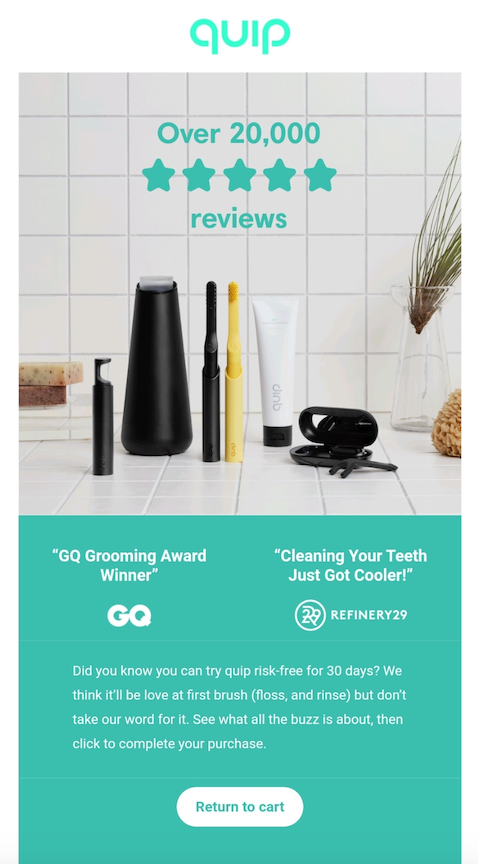
Social proof is a copywriting strategy that taps into our subconscious societal need to fit in, be part of a group, and trust the experiences of other members of the tribe. Examples of social proof include customer testimonials, product or service reviews, and statistics on the number of people who trust and choose a particular company.
The best part about social-proof emails is that you can approach them differently depending on the level of relationship your reader has with the brand. If it’s their first time on your website, it might be a good idea to throw some customer ratings and reviews their way to show that people trust you.
Or, if you’re dealing with a loyal client unsure about upgrading to a more expensive subscription plan, send them some recent case studies or success stories that will showcase the value of your product.
13. Experiment with different copywriting styles

Image source: Really Good Emails
Your business is unique. Your products, services, and branding all come together to form critical components of your online store. It’s important to communicate your brand identity consistently with a coherent tone of voice that matches your company values and engages your target audience.
If you’d like to have a go at working out some clever puns of your own, start with a list of keywords that describe what you do and who you are, and play around with the words. Make silly rhymes, change letters, and see what comes out of it.
Not only is this good fun and an amazing team-building exercise, but it’s also an effective way to attract more clients who share your vision and decrease cart abandonment rates of your online store.
In case you feel like wordplay is not your strongest suit, you can always hire a professional copywriter, a talented freelance writer, or partner up with an experienced content agency.
14. Make use of the curiosity gap

Human beings are curious creatures. Our minds enjoy a good puzzle. That’s why crime and mystery books are so popular. That’s also why people spend so much time glued to TV screens, desperate to find out what happens next to the characters they’ve become invested in.
If you pose the reader a question, and not necessarily a literal question, but rather something that makes them curious enough to feel the need to search for the answer, they will open the email. The rest is up to you.
This way, a witty follow-up message from the cart abandonment email can become a decisive element of your strategy that allows you to recover lost customers with ease.
15. Appeal to emotion

Image source: Pinterest
We all are ultimately emotional beings. There are universally recognized emotional tugs that, when used in a genuine and playful way, can encourage relatability between your brand and its customer.
Don’t be afraid to use this emotional appeal in your abandoned cart email campaign. Use a heartfelt copy in both your subject lines and email body. Insert relatable images and GIFs to evoke an emotional response in your reader, rather than simply having them read about it. You’d be surprised, but even the most mundane products, such as shovels, can be sold on emotion. You just need to remind customers why they were interested in it in the first place.
Master Cart Recovery with GetResponse
Transform abandoned carts into completed sales with proven email templates, smart automation, and personalization features that convert at industry-leading rates.
Best practices for using abandonment cart emails to entice customers
Having an abandoned cart email strategy is a useful tool in your email marketing campaign arsenal. It can boost cart recovery and bring back lost sales. An effective campaign can drive engagement, nurture qualified leads, combat cart abandonment, and turn seemingly lost deals into loyal customers.
During the years we’ve spent polishing our expertise in email marketing, we’ve been able to outline some of the best practices to help you with abandoned cart recovery:
1. Stay on brand
Brand voice is key to building trust with your audience. If your brand is punny, then by all means crack out the clever wordplay and tease your subscribers. But if you want to be perceived as a serious industry expert, banter like that will likely alienate your readers.
Authenticity is invaluable.
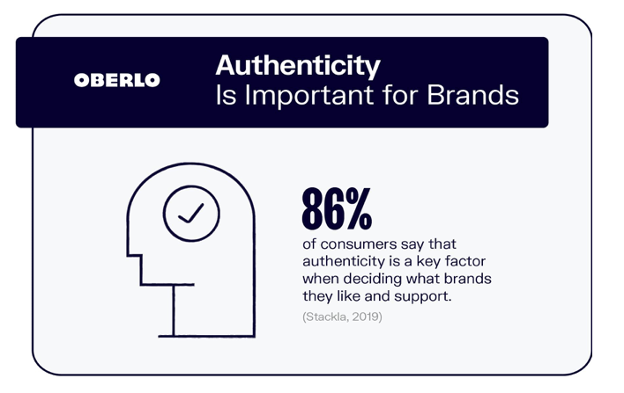
Image source: Oberlo
There is no hard and fast way to write an abandoned cart email, but one thing is for sure: make the email yours.
Stay genuine.
Stay consistent.
And above all else, stay driven by your customers.
2. Know your audience
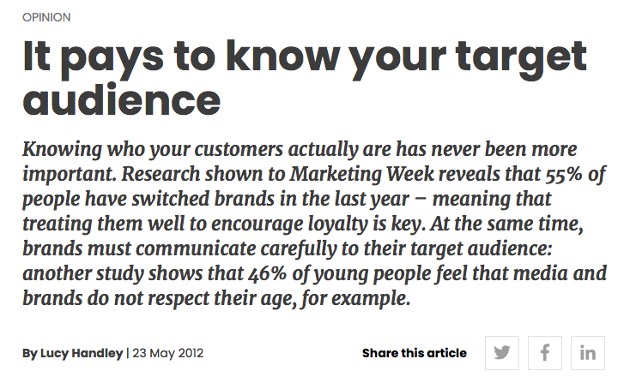
If you know your audience, which is absolutely essential for successful marketing, then you might be able to understand why your customers choose your competitors instead of completing their purchase with you.
Use your knowledge to speak directly to the people in your market share, i.e., the people who resonate with your brand and search your site for items they may want to buy. Address their specific concerns to encourage them to complete their orders.
3. Have a clear call-to-action
According to Wordstream, emails with a single CTA increased clicks by 371% and sales by 1617%. So it’s well worth taking the time to include a compelling call to action.
The CTA button in your abandoned cart email must clearly communicate to the reader:
a) that it is a clickable link
b) what they will find when they click it.
You shouldn’t be using the button to convince the reader to click. The copy before the CTA does that. The button itself should be a simple imperative statement:
- Go back to cart
- Back to basket
- View basket
- Checkout now
- Subscribe
- Get started with …
- Claim Offer
- Hire an expert
- Sign up now
4. Set up triggered response automations
Triggered response emails are a critical component of any email marketing strategy. They differ from promotional emails in that they are triggered when certain conditions are met by the customer, whereas newsletters and promotions tend to be sent in bulk regardless of the conditions.
Setting up an automated abandoned cart email can save you time in the long run, and they tend to be more effective than other forms of email because they address a specific need the customer has at the moment they need it.
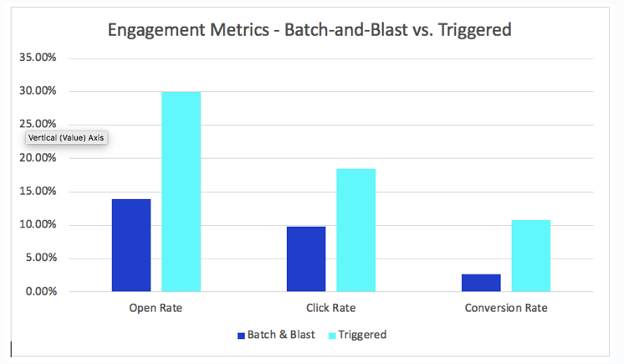
Image source: Wunderkind
Set up your first automated abandoned cart email with the email marketing company GetResponse! Our software allows you to choose from dozens of free newsletter templates, set up specific triggers, and stay online 24/7 with autoresponders.
Try it yourself right now for free
5. Experiment with A/B Testing
The best way to determine what works for your customers and what doesn’t is to send out multiple versions of an email and see which one receives the best response. You can do this by setting up two possible emails with a 50/50 split test.
Comparing the results and analyzing the reasons behind the observed open rates and click-through rates can be very illuminating. For example, you may find out that free shipping is a better incentive than a percentage discount when you want cart abandoners to go back and complete their orders.
Performing this sort of test will help you get to know your customers better so that you can meet their specific needs.
A/B testing is available on our free email marketing account, so you can see for yourself how valuable it can be for your business as you grow. From there, you can explore our email services, browse our customizable newsletter templates, or use our drag-and-drop email creator to design your own emails.
A/B testing your abandoned cart emails can reveal surprising insights. Sometimes free shipping beats percentage discounts, or emotional appeals outperform logical ones. Test everything to maximize your recovery rates.
Abandoned cart email FAQs
What is a good abandoned cart email?
A good abandoned cart email offers your client the chance to revisit the products they have selected on your site. The best converting examples of abandoned cart emails do so in a clear, aesthetically pleasing, and helpful way. They also include a link that goes directly to the customer’s cart and use incentives such as free shipping and coupon codes to boost conversions.
What is the easiest way to send an abandoned cart email?
For marketers who are not comfortable setting up automation workflows, the easiest way to use GetResponse’s ecommerce campaign feature. This doesn’t require technical skills, and it’s pretty easy to set up.
How long should I wait before sending an abandoned cart email?
The best time to send an abandoned cart email is within one hour of the cart getting abandoned, according to our data. A follow-up email should be sent after 24 hours.
The easiest way to get the timing right is through automation triggered by your subscribers’ behavior. Set up an automated workflow that sends your customers a reminder email as soon as they abandon their carts, rather than waiting a few hours to spot cart abandoners on your own. Our software offers a customizable, prebuilt abandoned cart flow you can edit and deploy within minutes.
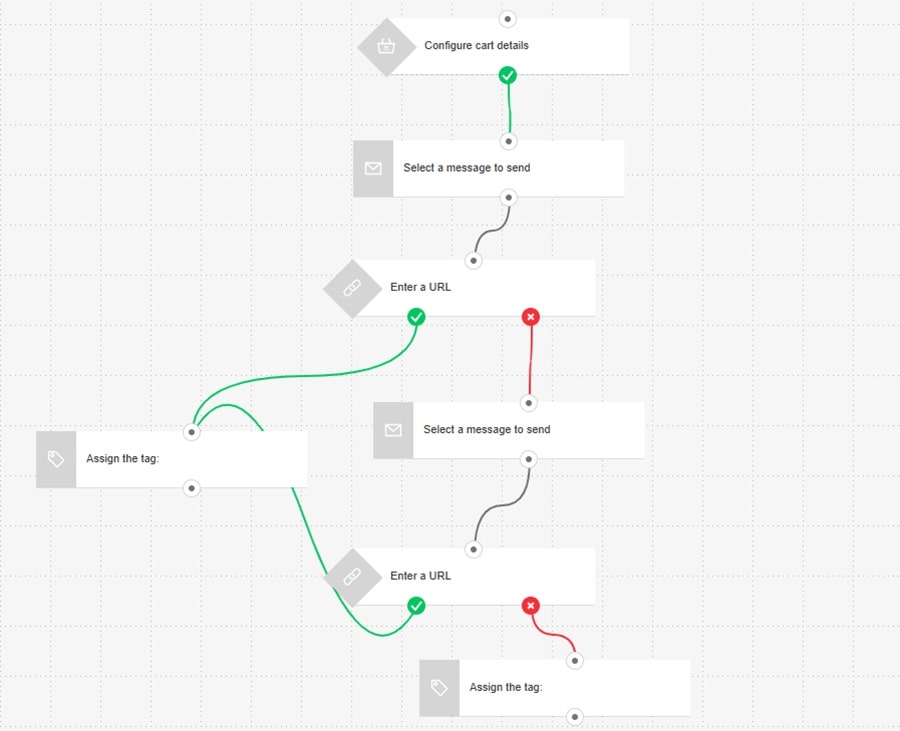
How many abandoned cart emails should you send?
Send up to three abandoned cart emails spaced out over three days. The first should be sent one hour after the cart was abandoned, the second 24 hours after, and the last one about 72 hours after that.
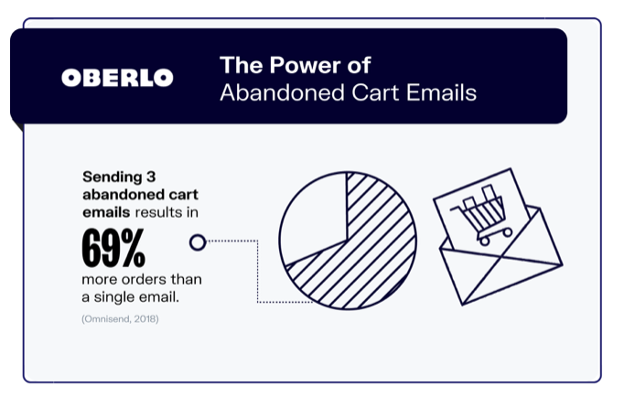
Image source: Oberlo
Do cart abandonment emails work?
Yes, cart abandonment emails work according to multiple studies. Oberlo reported that abandoned cart emails converted at about 4.64%, and while that figure may sound low, it is actually quite high when compared to click-through rates for other types of email.
It’s also impressive when you think of that in terms of annual turnover. For example, with a turnover of $100,000, that’s $4,640 in recovered revenue. Annex Cloud suggested that the conversion rate was as high as 10.7% in 2021.
Conclusion
There are many techniques, tactics, and designs for cart abandonment emails, and the ones that are right for you and your business will likely differ from those of your competitors.
The most effective way to address the shopping cart abandonment issue is with a divide-and-conquer strategy. You can take several measures to reduce abandonment in the first place. These include optimizing for mobile, having clear and consistent branding across your website and social media channels, as well as streamlining payment and delivery processes.
However, eradicating cart abandonment is impossible. There will always be abandoned carts caused by customer indecisiveness. What you can do is develop a customer service strategy that automatically triggers in response to abandoned items and attempts to recover lost sales. That’s where the abandoned cart email really comes into play.
Want to learn more about how to increase conversion on your abandoned cart emails? Check out our article 6 Rules for Recovering Lost Sales with Abandoned Cart Emails. You can also find out more about the benefits of marketing automation for ecommerce and how it can help you meet your business goals.
Or better yet, experience the full potential of marketing automation for ecommerce firsthand with GetResponse!
Want to see it in action first? Check out how easily you can set up abandoned cart campaigns with GetResponse!
